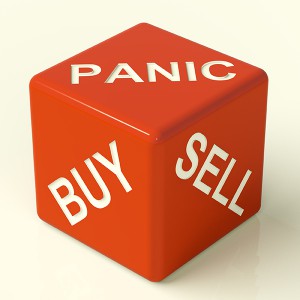 More than the high frequency traders, market makers, know-it-all analysts and hyped-up gurus, our biggest enemy as investors is ourselves. Navigating the emotional battleground of fear and greed is perhaps only surpassed by surviving puberty. Oh, what fun. But just as we managed to leave our high-strung teenage selves in the past, we can also mature into cool, calm and collected investors capable of crafting and executing high-probability trades in any circumstance.
More than the high frequency traders, market makers, know-it-all analysts and hyped-up gurus, our biggest enemy as investors is ourselves. Navigating the emotional battleground of fear and greed is perhaps only surpassed by surviving puberty. Oh, what fun. But just as we managed to leave our high-strung teenage selves in the past, we can also mature into cool, calm and collected investors capable of crafting and executing high-probability trades in any circumstance.
First things first, you have to have a rock-solid plan before you start trading. Rarely does consistent success come unplanned. In fact, I would go so far to say that consistent success never happens without a plan. Think about your average tourist who visits Vegas. The allure of the casinos is practically irresistible. Amid bells, whistles, dings and cha-chings, the happy Vegas visitor may get lucky and win a nice little pile of chips. Does he cash-in his chips and cheerfully walk away with bulging pockets?
Almost never.
The surge of excitement from winning speeds up the heart, short-circuits the brain, and leads directly to more gambling with bigger risk taking… until the cool, calm and collected casino gets it all back, and then some.
Of course, there’s always the poor schmuck that doesn’t get to ride the high of that first magical win. They’re in the hole from the start – and they just keep digging. They’re afraid to walk away. That would make the loss real. They desperately try to play their way back to breakeven. If they just keep playing, then surely, their luck will turn around. After all, they can’t lose every time, can they? Statistically speaking, probably not, but near enough that the occasional win won’t even make a dent in the damage they’ve done.
These two recreational gamblers contrast perfectly with a professional gambler. The person with a plan. They’ve calculated their odds, they know precisely how much risk to take based on those odds and they don’t let emotions get in their way. They don’t win every time, but they know how to stay in the game until they do. And here’s how you can too.
Never risk more than 1% of your portfolio value in a single trade. No, that doesn’t mean using a 1% stop-loss. (Well, it would if you invested the entire amount of your capital in one stock, but let’s assume that’s something you would never, ever, ever do.)
Let’s say you had a $100,000 portfolio. What’s 1% of 100k? $1,000. That’s the maximum loss allowed for a single stock in this portfolio. If you bought 10 stocks, investing $10,000 into each, your stop-loss would be 10%. 10% of $10,000 is $1,000, the most you could risk. If you had purchased 20 stocks at $5,000 each, you’re maximum stop-loss would be 20%. 20% of $5,000 is $1,000. This should force you to pay attention to your entry point, the volatility of your stock, and how much you invest.
Make the trend your friend. Contrarian investors are an endangered species. Unless you’ve got the bankroll of Buffett and nothing but time on your hands to wait for profits, quit trying to nail a bottom (a.k.a., catch a falling knife). Analyze the trend of the market before you even look twice at a stock. The market isn’t a separate entity, it’s composed of thousands of stocks – if it’s moving in any direction, it’s because there’s essentially a stampede of stocks heading that same direction. Do you really want to be the guy standing in the way of a stampede? (Please say no.)
How do you objectively determine the direction? If you have VectorVest, use our market timing signals. If you don’t, use a moving average on a major index like the S&P. You can get all kinds of fancy with market analysis, but just try looking at a 40, 65 or 100-day moving average to get your best balance between too late and too soon.
Basically, you need a long enough moving average to signal a significant trend that has the probability of being sustainable, even if you’re trading much shorter term. Once you’re in that trend, you want it to follow price closely enough that your portfolio won’t get killed before you get the signal the trend has broken down.
When the price of the index is above the moving average, it’s okay to buy stocks. If the price of the index drops below the moving average, stop buying and protect your profits by tightening stops, using options, hedging with contra ETFs or plain old selling.
Don’t buy stocks on speculation. Forget the hot ‘tips’ and do your homework. Speculation is a rich man’s hobby; it’s money you can afford to burn. Instead, buy stocks that are making money and making it consistently. VectorVest has indicators that evaluate a stock’s value based on earnings and earnings growth, as well as an indicator that assesses safety based on historical financial performance, but if you don’t have VectorVest, you can still determine what your stocks is worth. Here’s a quickie formula for determining a stock’s current value; Value=100*EPS/Interest Yield; Compare the stock and the value and decide whether any premium you’re paying is fair.
Next, look at the earnings growth for your stock (available online places like Yahoo etc.). The stock’s EY should be higher than the combination of interest rates and inflation. If you take just a few minutes to check these things out, you can ensure some minimum fundamental strength for a stock. Even if you consider yourself a short-term investor, I think you’ll be impressed by how much easier it is to make money on ‘good’ stocks than bad.
Buy stocks that are already doing what you want them to do. Think back to that “catch a falling knife” reference. Does that sound like a fun activity? (Please say no.) Forget the bottoms; it’s so much easier (and probable…and repeatable) to take a nice little chunk of profit out of the middle. The same techniques that we used to analyze the market’s trend above can now be used to identify the stock’s trend.
In addition to price trading above the moving average, look for the stock’s price to be steadily rising from bottom-left to upper-right on a one year graph, the smoother the better. More often than not, predictable stock charts equal predictable profits.
Know when to hold ‘em, know when to fold ‘em. Ahh, the hardest question of all, especially for an emotional investor, is when to let a stock go. You would think they were children you’re afraid to kick out of the nest. They’re not. They have no emotions, you won’t hurt their feelings, if they aren’t behaving and paying their way – Kick. Them. Out.
If they’ve been good, but start to go bad – Kick. Them. Out. They’re costing you time and money. (Oops, I guess they are like kids, but without all the perks that make us love them anyway). Again though, we have to have an objectionable way to determine when to let go, since Fear and Greed are more likely to wrestle control from you here than anywhere else.
Trailing stops and gain losses are popular exit strategies. The amount of either should not risk more than 1% of your portfolio value in a single position. They’re also dependent on your goals and risk tolerance. Short quick gains tend to result in more winners, while more generous stops allow for bigger winners. Short quick gains may also lend more power to compounding profits; with each small gain, you’re leveraging more money into the next position. Rinse and repeat.
To prevent whipsaws, particularly in shorter-term positions, pay attention to your entry point. Avoid buying at overbought levels by looking at the RSI or Stochastic. There’s plenty of free, easy to understand information on both of these indicators (Google is your friend), but their purpose in life is to identify overbought and oversold positions. Don’t buy when the indicator shows price is in overbought territory.
Also, pay attention to how far price has pulled away from the moving average you’re using. Extremes tend to revert back to the norm. If you choose to ignore this (at your own peril), then keep yourself out of trouble using a trend line or a short-term moving average to follow the stock’s parabolic rise very closely.
Look at the ATR (Average True Range) of a stock, another common and popular technical indicator. Multiply the ATR by 2 to 3. It’s quite likely the stock could have a pullback to these levels. Can your stop loss accommodate that? If not, you should wait for a better entry or move on to the next stock.
Finally, when it comes to selling, never lose more than half your profit. While a trailing stop trails the stock’s price, a profit trailing follows the profits and snaps in when they start to slip by your specified percentage. Some broker’s offer this, others you’ll need to track manually. Simply put, if you reach 10% profit and they slip to 5% because the stock is now retreating, sell. And never, ever let a profit turn into a loss, even if you have to sell at breakeven.
There’s a lot more that could be said on this subject, but my fingers are starting to cramp from typing, so I’ll save that for another article. Hopefully, these tips will help you fill some gaps in your current trading plan or maybe get you started in formulating one. Think of your trading plan as a battle plan, one that will help you win the war against your emotions and defeat fear and greed for good.



Leave A Comment